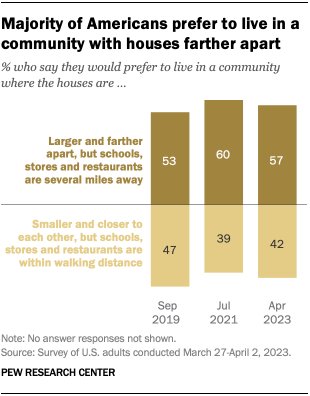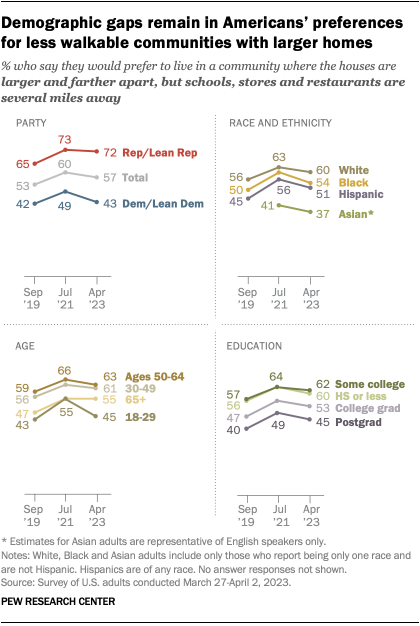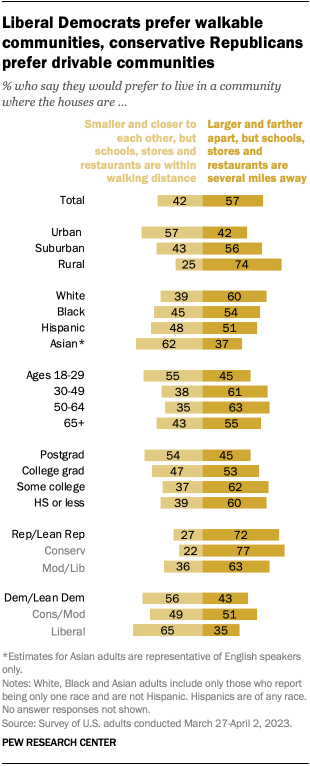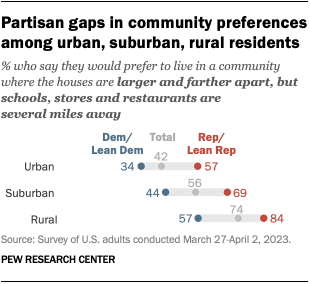A majority of Americans (57%) say they would prefer to live in a community where “houses are larger and farther apart, but schools, stores and restaurants are several miles away,” according to a Pew Research Center survey conducted March 27-April 2, 2023. About four-in-ten (42%) would prefer a community where “houses are smaller and closer to each other, but schools, stores and restaurants are within walking distance.”
To assess Americans’ attitudes about where they live and which types of communities they would prefer, Pew Research Center surveyed 5,079 U.S. adults between March 27 and April 2, 2023.
Everyone who took part is a member of the Center’s American Trends Panel (ATP), an online survey panel that is recruited through national, random sampling of residential addresses. This way nearly all U.S. adults have a chance of selection. The survey is weighted to be representative of the U.S. adult population by gender, race, ethnicity, partisan affiliation, education and other categories. Read more about the ATP’s methodology.
Here are the questions used in this post, along with responses, and its methodology.

The share of the public that prefers more spread-out communities is roughly similar to two years ago, when six-in-ten Americans said this. Public preferences were more evenly divided on this question in fall 2019, a few months before the coronavirus outbreak.
As in the past, there are differences in these preferences by party, age, education, race and ethnicity, and community type.
Partisanship

Republicans have consistently been more likely than Democrats to express a preference for communities with larger houses. Currently, 72% of Republicans and Republican leaners, compared with 43% of Democrats and Democratic leaners, would opt for this type of community.
Age
While a majority of adults ages 30 and older would prefer communities with larger homes over those with more walkability, adults under 30 are somewhat more likely to express the opposite preference. This reflects a modest shift from 2021, when 55% of 18- to 29-year-olds preferred communities with larger homes. That share has dropped 10 percentage points over the last two years.
Education
Americans who do not have a bachelor’s degree are more likely than those with more formal education to prefer communities with larger houses. About six-in-ten of those with some college experience or less education (61%) say they would prefer this, compared with 53% of those with a bachelor’s degree and 45% of those with a postgraduate degree.
Race and ethnicity
Six-in-ten White adults say they would prefer communities that are more spread out, as do about half of Black (54%) and Hispanic adults (51%).
By comparison, 62% of Asian adults would prefer more walkable communities with smaller houses.
Ideology

About three-quarters of conservative Republicans (77%) say they would prefer more spread-out communities with larger houses, as do 63% of moderate and liberal Republicans.
Conservative and moderate Democrats are nearly evenly divided in their community preference: 51% say they would prefer a community that is more spread out, while 49% would prefer one that is more walkable.
In contrast, 65% of liberal Democrats express a preference for smaller houses in more walkable places.
Community type
About three-quarters of Americans who describe their own communities as rural (74%) say they would prefer to live in places where houses are larger and farther apart, but also farther from schools, stores and restaurants. A narrower majority of suburban Americans (56%) also say they would prefer places with larger houses.
In contrast, more Americans who currently live in urban areas (57%) say they would prefer a community with smaller houses that are within walking distance of schools, stores and restaurants.
Community type and partisanship

Among urban, suburban and rural residents, Republicans are much more likely than Democrats to want to live in communities where houses are larger and more spread out.
While 84% of rural Republicans say they prefer more spread-out communities, 57% of rural Democrats say the same. Among those who live in urban communities, 57% of Republicans and 34% of Democrats would prefer to live somewhere where homes are larger and farther apart.
Note: Here are the questions used in this post, along with responses, and its methodology. This is an update of a post originally published Aug. 26, 2021, written by former Research Assistant Vianney Gómez.

Credit: Source link
